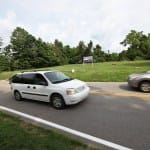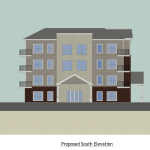Wisler leads short-handed plan commission in review of Moores Pike PUD, other projects





At Monday’s meeting of the Bloomington plan commission, a planned unit development (PUD) for 2.2 acres of land on Moores Pike, with 80 apartments in one 50-foot, four-story building, was forwarded to the city council with a negative recommendation.
In other business, which did not get final action from the commission, a proposed “mini-warehouse” facility on West 3rd Street across the road from Culver’s Restaurant, was continued to the plan commission’s November meeting.
A mixed use PUD proposed for the northwest corner of E. Longview Avenue and S. Pete Ellis Drive, with 19,000 square feet of commercial space, 264 apartments and a 306-space parking deck, was approved for its second of two required hearings, to be held in front of the plan commission next month.
After the departure of Joe Hoffmann last month, the plan commission’s first order of business at its Monday meeting was to elect a new president. Brad Wisler, as vice president, was an unsurprising choice. But due to the commission’s diminished numbers it required a unanimous vote—which it got—of the other five commissioners present. Nick Kappas was nominated and approved as vice president by the same 5-0 tally. (Nominees did not participate in those votes.)
The five votes required on the nine-member commission is the minimum needed for action on any item. Because only eight members are currently serving—a replacement for Hoffmann has not yet been announced—and because Flavia Burrell and Jillian Kinzie were absent, that left a one-vote margin for discord on other agenda items.
The five-vote minimum factored into two of the commission’s votes.
The vote on the W. 3rd Street storage facility was 4-2 to recommend approval, with dissent from Nick Kappas and Beth Cate, who said that they did not think that the proposed use, while permitted, was consistent with the spirit of the city’s comprehensive plan. That meant the motion failed, which translates to no action.
The consequence of the failed motion, development services manager Jackie Scanlan told the commission, was that the project would be automatically continued to next month’s meeting. To make the continuance clear, commissioners voted 6–0 to continue the project to their Nov. 4 meeting.
The vote on the negative recommendation for the Moores Pike PUD was 5-1, with Kappas dissenting on the vote, meaning he voted in support of the project. Before the vote was called, based on commissioner comments, the project had at least four votes against it.
Wisler got clarification from city planning staff that lack of a 5-vote majority on a motion either way would result in a continuance. (If the commission is still short a member in November, the four votes against the project would mean that the project couldn’t be forwarded to the city council with a positive recommendation.)
Wisler was first to vote on the roll call and joined the other four commissioners who’d indicated they’d be voting no.
Public commentary delivered at the meeting and written comments included in the meeting packet were uniformly against the project—based on the height of the building, the impact on the already high traffic volume on Moores Pike, and drainage, among several other concerns.
Compared to a previous version of the project, a reduction in building height, from 60 to 50 feet, and designation of 10-percent of units as affordable were not enough to convince planning staff to recommend supporting the project:
While this petition does provide an affordable housing component, the affordable housing commitment does not meet the City’s expectations nor is it consistent with previous projects or the direction of the new UDO. The Department feels that the design of the building places the side of the building on Moores Pike rather than a true front and does not adequately create a pedestrian friendly streetscape as encouraged by the Comprehensive Plan. In addition, the petitioner has not shown a sufficient level of sustainable design features to promote environmentally sustainable design. In addition, some of the neighbor’s concerns regarding adding additional parking spaces or reducing the number of stories in the building were addressed.
Developer Mark Figg told the commission he’d done the calculations for making the affordable mix 15 percent, following the city’s HAND department guidelines, and with that mix, he couldn’t make the project financially viable. He’d also tried removing a floor from the building. “I just can’t do it,” he said, “It is what it is.”
Kappas described why he supported the project by saying that the mix of bedroom sizes—one- and two-bedroom units—and everything else about the project suggested it was designed to appeal to anyone. That is, it is not a student-oriented development. Kappas also said he drives Moores Pike everyday, and had the opportunity to see the lot and how it’s situated with the surrounding houses to the south.
Kappas did have some criticisms—he felt the building would be better if it were one floor shorter. And town homes, instead of the proposed apartment building, would be “fantastic,” Kappas said. Kappas said he felt that the project would act as a transition from the College Mall area to two other neighborhoods.
The connectivity among neighborhoods on the southeast side of town, where the project is located, was raised during public commentary by Greg Alexander. That part of town is currently a “maze of cul-de-sacs,” he said. And the proposed PUD would be an opportunity to implement part of the city’s newly adopted transportation plan, which aims to address the lack of a grid in that part of town, by adding connecting streets.
The specific new connection mentioned by Alexander is one of 67 new connections listed in the transportation plan:
NC-61 S Pickwick Pl extension Extend S Pickwick Pl from S Winfield Rd to S Clarizz Blvd
About the new connections, the transportation plan says:
The City of Bloomington should require developments to construct new connections where feasible, seek opportunities to partner with private development to construct new connections, and pursue new connections that would significantly improve transportation connectivity.




Comments ()